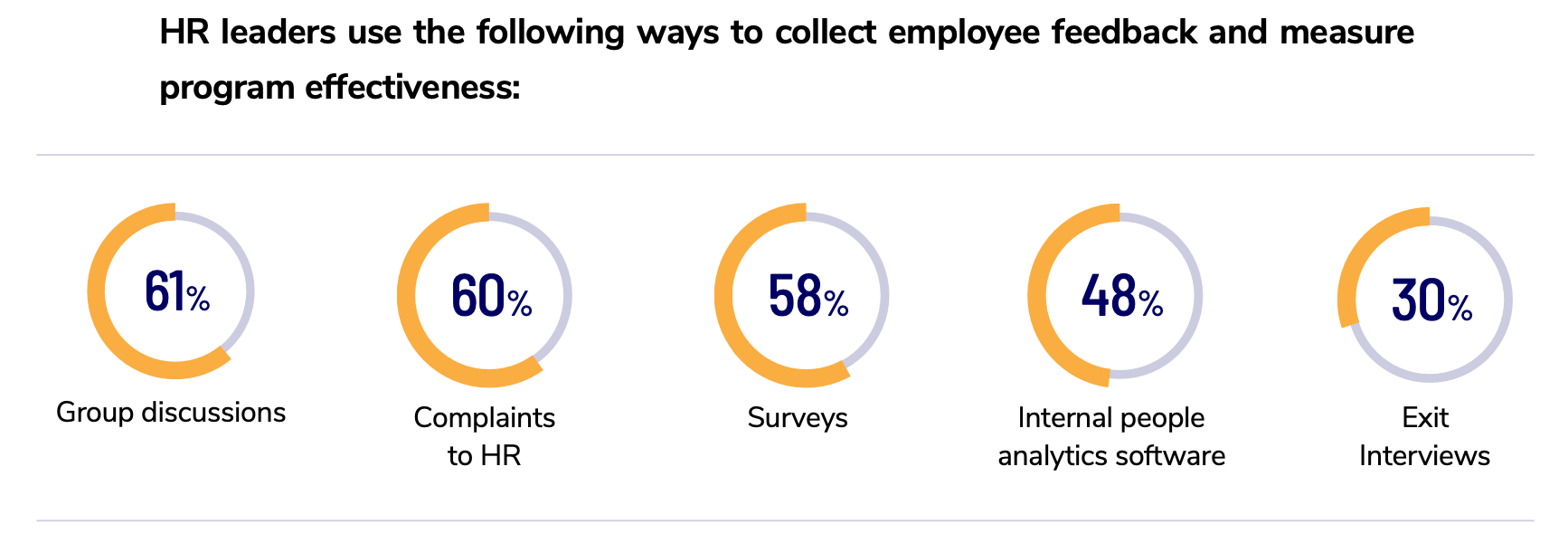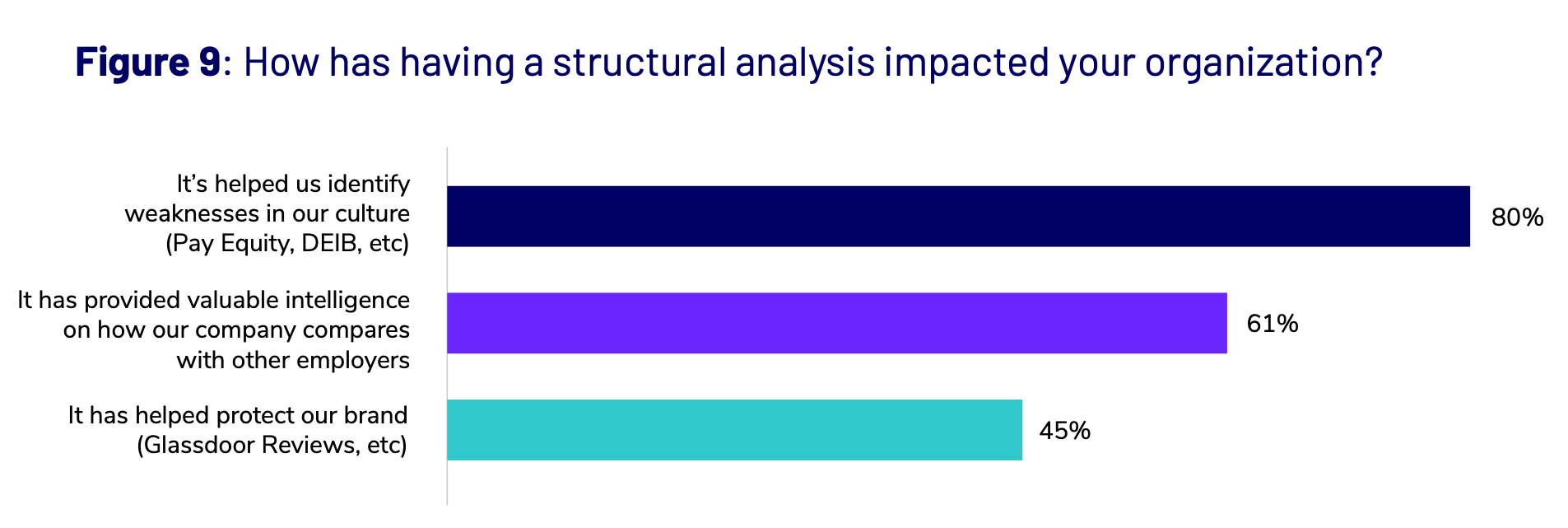Only 50% of employees trust their organization – a far cry from what it should be. One step to building that trust is routinely collecting feedback through employee experience surveys and acting on that data.
Here are a few best practices for collecting high-quality employee feedback. By utilizing these techniques, HR teams can reveal the true pulse of their workforce and drive meaningful improvements.
1. Use a Variety of Data Collection Methods
Want a higher eNPS score? Use multiple methods of data collection.
Research shows that organizations with an eNPS score of 51 or higher use various methods – like 1:1 evaluations, employee experience surveys, and leadership turnover – to improve company culture and retention rates.
Various data collection methods allow HR teams to gauge employee engagement and bridge the gap between numerical data and real, on-the-ground experiences within the company. And while many companies are using different ways to collect employee feedback, the data below illustrates the many opportunities HR teams have to tap into employee data.

Employing various data collection methods (that yield valuable, context-rich employee feedback) is essential for making informed, actionable decisions. Research shows that there is room to grow in this area.
Tip: Always do your due diligence after receiving complaints to see how widespread the issue is. That way, you can determine if you need to work one-on-one with the reporting employee or create a plan of action that affects the whole team or company.
2. Send Focused Employee Feedback Surveys
Your data is only as good as the questions you ask. It’s essential to go beyond simple questions like, “Are you happy working here?”
Your questions should probe whether employees are truly engaged, understand their roles, and see how they contribute to the business’s success.
Tailor the questions to uncover what you need to know about your company and be mindful of survey fatigue. Limiting the number of employee feedback surveys is essential for keeping fatigue (for you and employees) to a minimum.
Aim to ask questions that tie into the company’s purpose, employee engagement, and overall employee experience. Consider incorporating questions such as:
- How well do you understand the company’s business strategy and long-term goals?
- How well do you understand how your role aligns with company objectives?
- Can you explain the company’s mission and purpose in your own words?
- Have you been informed of the company’s new goals, strategies, and changes?
- Do you need help with work?
- Are there an adequate amount of advancement opportunities available?
Tip: Consider using a QFA Framework (Question, Follow-Up, Action) to collect unbiased data, gain context, and build trust through visible action across your organization.
3. Train Managers to Collect Quality Employee Insights
Using data from manager meetings is a powerful way to determine recurring themes and patterns that indicate broader organizational issues and opportunities.
That’s because managers connect the dots between critical concerns that may not be evident in employee experience survey results alone. By relaying this qualitative feedback to HR, managers help bridge the gap between frontline experiences and strategic decision-making.
It all comes down to training and setting expectations. Lillit Cholakian of NewGen Global Leaders states, “Initial and ongoing training, mentoring and coaching are critical to every manager’s effectiveness, influence and success, and hence, the company’s success.”
To create a foundation for productive one-on-one meetings, HR leaders should:
- Set clear expectations for managerial roles
- Create agendas or templates for managers across the organization to use
- Emphasize the importance of active listening
- Coach managers on facilitating open discussions where employees can share their thoughts, challenges, and aspirations
A mixture of quick pulse surveys and one-on-one conversations will ensure you collect high-quality, actionable data.
Tip: It’s critical to consider how you’ll collect feedback from managers regarding their 1:1s – without losing direct reports’ trust. Gather manager feedback about the process so everyone feels comfortable moving forward.
4. Time Your Surveys Wisely
Conducting employee engagement surveys at the right moments is vital to gathering meaningful and relevant feedback. Implement surveys after significant company events, policy changes, or during key phases of the employee lifecycle to ensure feedback reflects current experiences.
Well-timed surveys prevent fatigue and demonstrate to employees that their input is valued at critical junctures. You can also capture actionable employee insights directly applicable to ongoing initiatives and strategic planning.
Tip: To bolster your employee experience surveys, involve managers in the feedback collection process. As the primary point of contact between the organization and employees, managers can clarify the purpose of surveys and help employees feel comfortable sharing their honest opinions.
5. Utilize Exit Interviews
We’ve said it once, and we’ll say it again: offboarding is a vastly overlooked stage in the employee lifecycle.
Only 42% of HR leaders say they have a very standardized offboarding process (AKA, every departing employee receives the same documents, processes, and exit surveys).
That’s an oversight, because the information shared in exit interviews is gold. Because the departing employee is out the door, they’re not afraid of retribution (whether that’s a thing at your company or not), meaning they’ll give honest feedback about your employee lifecycle.

Check out the results of HR leaders below who have used offboarding employee experience data to improve their programming.
Tip: Don’t get defensive. What departing employees say may hurt your feelings, but this valuable information will help identify areas of program improvement. Listen, ask follow-up questions, and leave the conversation with a clear understanding and in a positive light.
Use Data to Strengthen Your Employee Experience
When it comes to your employee experience strategy and programming, data is your best friend. By intentionally using employee feedback surveys, HR teams can gauge employee engagement and bridge the gap between numerical data and real, on-the-ground experiences within the company.
Of course, the next step is to effectively prioritize and use the data to create a stronger employee experience and build mutual trust between employees and your organization. The result? Increased engagement, retention, and positivity in the workplace.









